2016 HONDA CIVIC COUPE seats
[x] Cancel search: seatsPage 3 of 585
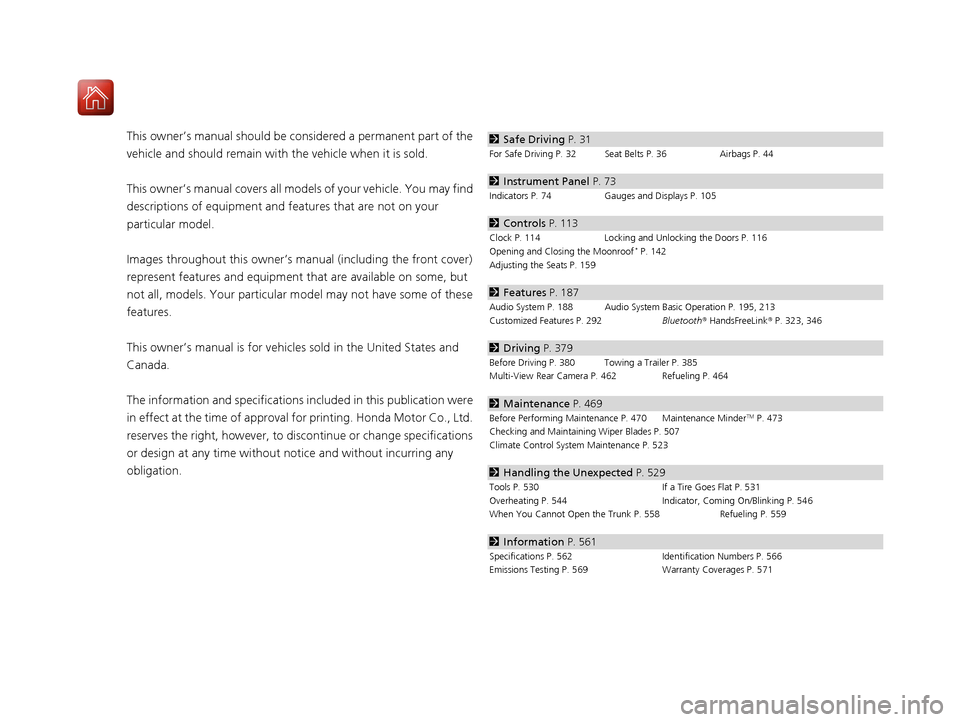
Contents
This owner’s manual should be considered a permanent part of the
vehicle and should remain with the vehicle when it is sold.
This owner’s manual covers all models of your vehicle. You may find
descriptions of equipment and features that are not on your
particular model.
Images throughout this owner’s manual (including the front cover)
represent features and equipment that are available on some, but
not all, models. Your particular mo del may not have some of these
features.
This owner’s manual is for vehicles sold in the United States and
Canada.
The information and specifications in cluded in this publication were
in effect at the time of approval for printing. Honda Motor Co., Ltd.
reserves the right, however, to discontinue or change specifications
or design at any time without notice and without incurring any
obligation.2 Safe Driving P. 31
For Safe Driving P. 32 Seat Belts P. 36 Airbags P. 44
2Instrument Panel P. 73
Indicators P. 74 Gauges and Displays P. 105
2Controls P. 113
Clock P. 114 Locking and Unlocking the Doors P. 116
Opening and Closing the Moonroof *
P. 142
Adjusting the Seats P. 159
2 Features P. 187
Audio System P. 188 Audio System Basic Operation P. 195, 213
Customized Features P. 292 Bluetooth® HandsFreeLink ® P. 323, 346
2 Driving P. 379
Before Driving P. 380 Towing a Trailer P. 385
Multi-View Rear Camera P. 462 Refueling P. 464
2Maintenance P. 469
Before Performing Maintenance P. 470 Maintenance MinderTM
P. 473
Checking and Maintaining Wiper Blades P. 507 Climate Control System Maintenance P. 523
2Handling the Unexpected P. 529
Tools P. 530 If a Tire Goes Flat P. 531
Overheating P. 544 Indicator, Coming On/Blinking P. 546
When You Cannot Open the Trunk P. 558 Refueling P. 559
2Information P. 561
Specifications P. 562 Identi fication Numbers P. 566
Emissions Testing P. 569 Warranty Coverages P. 571
16 CIVIC 2D HC2 (0A 01 0C)-31TBG6000.book 2 ページ >0>.>/6年>0月>/>0日 金曜日 午後4時>/6分
Page 11 of 585

10
Quick Reference Guide
Safe Driving (P 31)
Airbags (P 44)
● Your vehicle is fitted with ai rbags to help protect you and
your passengers during a moderate-to-severe collision.
Child Safety (P 58)
● All children 12 and younger should be seated in the rear seat.
● Smaller children should be properly restra ined in a forward-facing child seat.
● Infants must be properly restraine d in a rear-facing child seat.
Exhaust Gas Hazard (P 70)
● Your vehicle emits dangerous exhaust gases that contain carbon
monoxide. Do not run the engine in confined spaces where carbon
monoxide gas can accumulate.
Before Driving Checklist (P 35)
● Before driving, check that the front seats, head restraints,
steering wheel, and mirrors have been properly adjusted. Seat Belts
(P 36)
● Fasten your seat belt and sit upright well
back in the seat.
● Check that your passengers are wearing
their seat belts correctly.
Fasten your lap belt as
low as possible.
16 CIVIC 2D HC2 (0A 01 0C)-31TBG6000.book 10 ページ >0>.>/6年>0月>/>0日 金 曜日 午後4時>/6分
Page 36 of 585

35
uuFor Safe DrivinguSafety Checklist
Safe Driving
Safety Checklist
For the safety of you and your passengers, make a habit of checking these items
each time before you drive. •After everyone has entered the vehicle, be sure both doors are closed and locked.
Locking the doors helps prevent an occupant from being ejected and an outsider
from unexpectedly opening a door. 2 Locking/Unlocking the Doors from the Inside P. 126
• Adjust your seat to a position suitable for driving. Be sure the front seats are
adjusted as far to the rear as possible while allowing the driver to control the
vehicle. Sitting too close to a front airbag can result in serious or fatal injury in a
crash. 2 Adjusting the Seats P. 159
• Adjust head restraints to the proper position. Head restraints are most effective
when the center of the head restraint alig ns with the center of your head. Taller
persons should adjust their head restraint to the highest position.
2 Adjusting the Front Head Restraints P. 162
• Always wear your seat belt, and make sure you wear it properly. Confirm that any
passengers are properly belted as well. 2 Fastening a Seat Belt P. 40
• Protect children by using seat belts or chil d seats according to a child’s age, height
and weight. 2 Child Safety P. 58
1Safety Checklist
If the door and trunk open indicator is on, a door or the trunk is not completely closed. Close both doors
tightly until the indicator goes off. 2 Door and Trunk Open Indicator *
P. 81
If the door and trunk ope n message appears on the
driver information interface , a door and/or the trunk
is not completely closed. Close both doors and the
trunk tightly until th e message disappears.
2 Driver Information Interface Warning and
Information Messages *
P. 93
Models with information display
Models with driver information interface
* Not available on all models
16 CIVIC 2D HC2 (0A 01 0C)-31TBG6000.book 35 ページ >0>.>/6年>0月>/>0日 金 曜日 午後4時>/6分
Page 37 of 585

36
Safe Driving
Seat Belts
About Your Seat Belts
Seat belts are the single most effective safety device because they keep you
connected to the vehicle so that you can take advantage of many built-in safety
features. They also help keep you from be ing thrown against the inside of the
vehicle, against other passengers, or out of the vehicle. When worn properly, seat
belts also keep your body pr operly positioned in a crash so that you can take full
advantage of the additional protec tion provided by the airbags.
In addition, seat belts help protect you in almost every type of crash, including: - frontal impacts
- side impacts
- rear impacts
- rollovers
■ Lap/shoulder seat belts
All five seating positions are equipped with lap/shoulder seat belts with emergency
locking retractors. In normal driving the re tractor lets you move freely while keeping
some tension on the belt. During a collision or sudden stop the retractor locks to
restrain your body. The rear seat belts al so have a lockable retractor for use with
child seats. 2 Installing a Child Seat with a Lap/Shoulder Seat Belt P. 65
1About Your Seat Belts
Seat belts cannot completely protect you in every
crash. But in most cases, seat belts can reduce your
risk of serious injury.
Most states and all Canadian provinces and territories
require you to w ear seat belts.
The emergency locking retrac tor may lock if you lean
forward too quickly. Slower movements will allow
the belt to extend fu lly without locking.
3WARNING
Not wearing a seat belt properly increases
the chance of serious injury or death in a
crash, even though your vehicle has
airbags.
Be sure you and your passengers always
wear seat belts and wear them properly.
16 CIVIC 2D HC2 (0A 01 0C)-31TBG6000.book 36 ページ >0>.>/6年>0月>/>0日 金 曜日 午後4時>/6分
Page 40 of 585
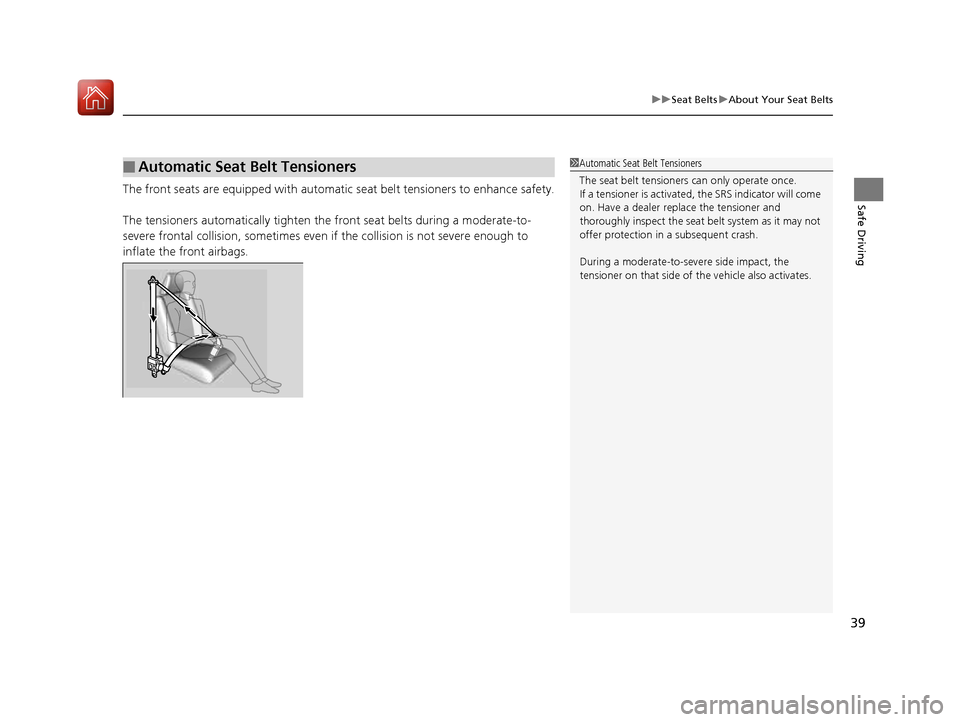
39
uuSeat BeltsuAbout Your Seat Belts
Safe DrivingThe front seats are equipped with automatic seat belt tensioners to enhance safety.
The tensioners automatically tighten the front seat belts during a moderate-to-
severe frontal collision, sometimes even if the collision is not severe enough to
inflate the front airbags.
■Automatic Seat Belt Tensioners1Automatic Seat Belt Tensioners
The seat belt tensioners can only operate once.
If a tensioner is activated, the SRS indicator will come
on. Have a dealer replace the tensioner and
thoroughly inspect the seat belt system as it may not
offer protection in a subsequent crash.
During a moderate-to-sev ere side impact, the
tensioner on that side of the vehicle also activates.
16 CIVIC 2D HC2 (0A 01 0C)-31TBG6000.book 39 ページ >0>.>/6年>0月>/>0日 金 曜日 午後4時>/6分
Page 41 of 585
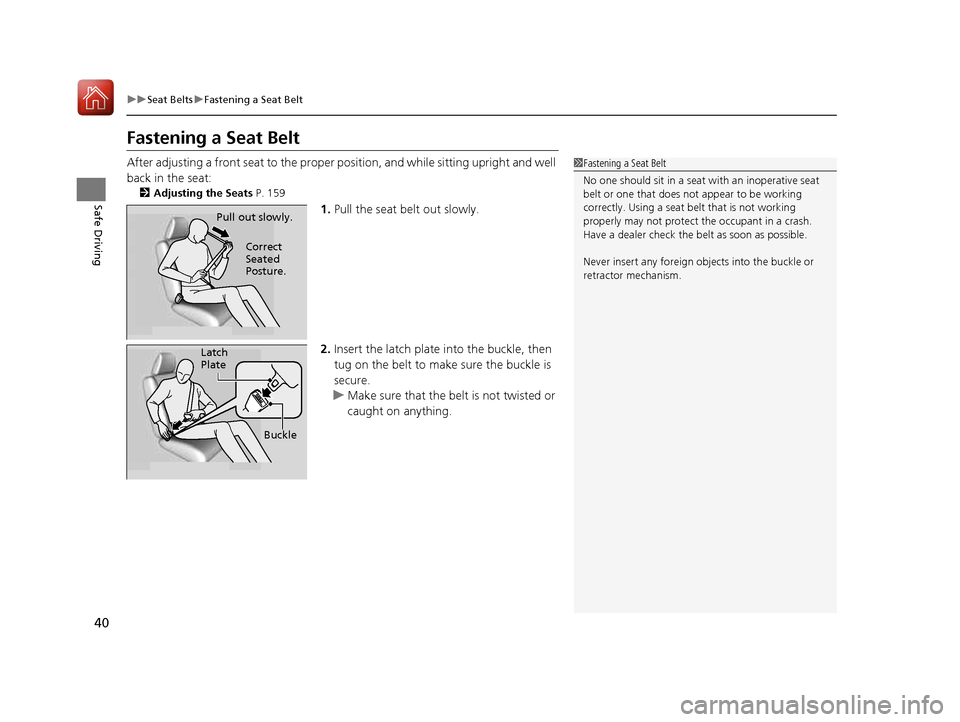
40
uuSeat BeltsuFastening a Seat Belt
Safe Driving
Fastening a Seat Belt
After adjusting a front seat to the proper position, and while sitting upright and well
back in the seat: 2 Adjusting the Seats P. 159
1.Pull the seat belt out slowly.
2. Insert the latch plate into the buckle, then
tug on the belt to make sure the buckle is secure.
uMake sure that the belt is not twisted or
caught on anything.
1Fastening a Seat Belt
No one should sit in a seat with an inoperative seat
belt or one that does not appear to be working
correctly. Using a seat be lt that is not working
properly may not protect the occupant in a crash.
Have a dealer check the belt as soon as possible.
Never insert any foreign obj ects into the buckle or
retractor mechanism.
Pull out slowly.
Correct
Seated Posture.
Latch Plate
Buckle
16 CIVIC 2D HC2 (0A 01 0C)-31TBG6000.book 40 ページ >0>.>/6年>0月>/>0日 金 曜日 午後4時>/6分
Page 48 of 585
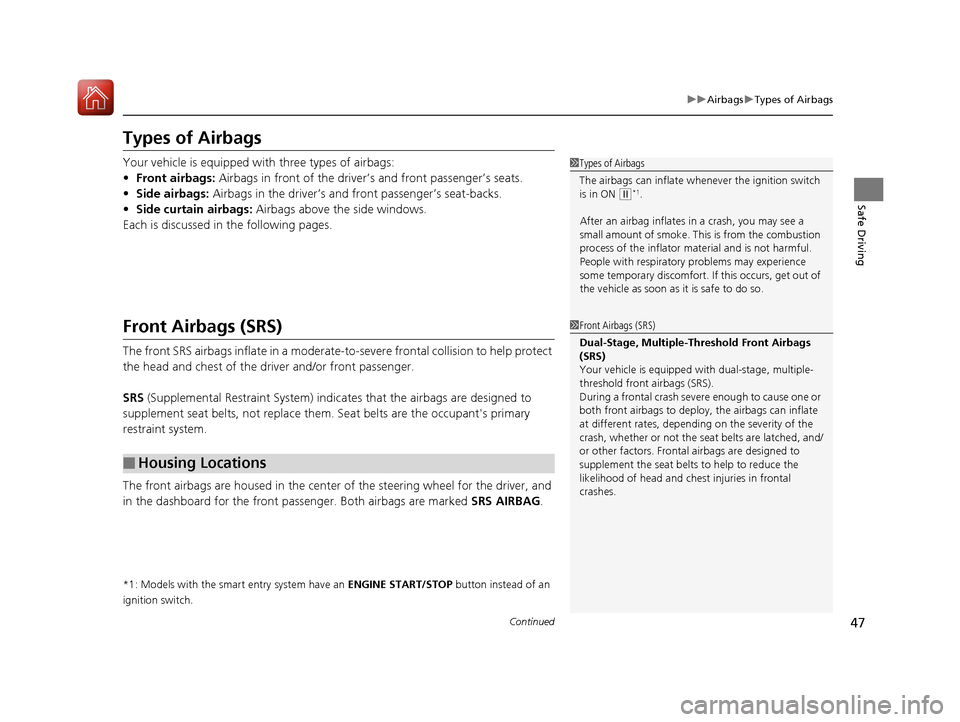
47
uuAirbagsuTypes of Airbags
Continued
Safe Driving
Types of Airbags
Your vehicle is equipped with three types of airbags:
• Front airbags: Airbags in front of the driver’s and front passenger’s seats.
• Side airbags: Airbags in the driver’s and front passenger’s seat-backs.
• Side curtain airbags: Airbags above the side windows.
Each is discussed in the following pages.
Front Airbags (SRS)
The front SRS airbags inflate in a moderate-to-severe frontal collision to help protect
the head and chest of the driver and/or front passenger. SRS (Supplemental Restraint System) indica tes that the airbags are designed to
supplement seat belts, not replace them . Seat belts are the occupant's primary
restraint system.
The front airbags are housed in the center of the steering wheel for the driver, and
in the dashboard for the front pass enger. Both airbags are marked SRS AIRBAG.
*1: Models with the smart entry system have an ENGINE START/STOP button instead of an
ignition switch.
■Housing Locations
1Types of Airbags
The airbags can inflate whenever the ignition switch
is in ON
(w *1
.
After an airbag inflates in a crash, you may see a
small amount of smoke. This is from the combustion
process of the infl ator material and is not harmful.
People with respiratory pr oblems may experience
some temporary discomfort. If this occurs, get out of
the vehicle as soon as it is safe to do so.
1Front Airbags (SRS)
Dual-Stage, Multiple-Threshold Front Airbags
(SRS)
Your vehicle is equipped wi th dual-stage, multiple-
threshold front airbags (SRS).During a frontal crash severe enough to cause one or
both front airbags to deploy, the airbags can inflate
at different rates, dependi ng on the severity of the
crash, whether or not the se at belts are latched, and/
or other factors. Frontal airbags are designed to
supplement the seat belts to help to reduce the
likelihood of head and chest injuries in frontal
crashes.
16 CIVIC 2D HC2 (0A 01 0C)-31TBG6000.book 47 ページ >0>.>/6年>0月>/>0日 金 曜日 午後4時>/6分
Page 51 of 585
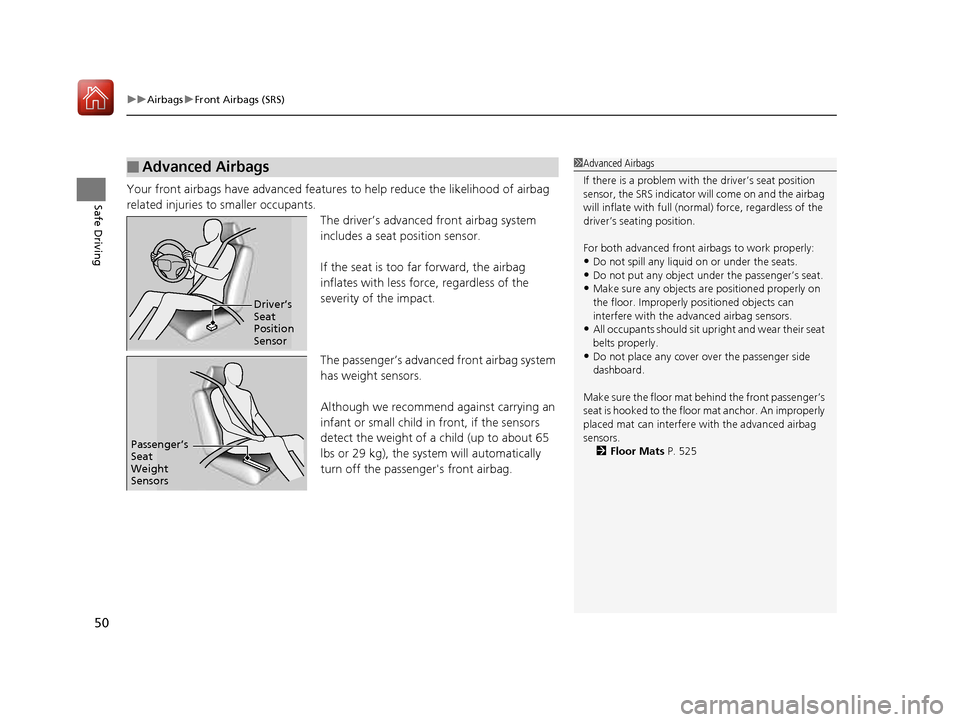
uuAirbagsuFront Airbags (SRS)
50
Safe DrivingYour front airbags have advanced features to help reduce the likelihood of airbag
related injuries to smaller occupants. The driver’s advanced front airbag system
includes a seat position sensor.
If the seat is too far forward, the airbag
inflates with less forc e, regardless of the
severity of the impact.
The passenger’s advanced front airbag system
has weight sensors.
Although we recommend against carrying an
infant or small child in front, if the sensors
detect the weight of a child (up to about 65
lbs or 29 kg), the syst em will automatically
turn off the passenger's front airbag.
■Advanced Airbags1Advanced Airbags
If there is a problem with the driver’s seat position
sensor, the SRS indicator wi ll come on and the airbag
will inflate with full (normal) force, regardless of the
driver’s seating position.
For both advanced front airbags to work properly: • Do not spill any liquid on or under the seats.
• Do not put any object under the passenger’s seat.
• Make sure any objects are positioned properly on the floor. Improperly pos itioned objects can
interfere with the advanced airbag sensors.
• All occupants should sit upri ght and wear their seat
belts properly.
• Do not place any cover over the passenger side dashboard.
Make sure the floor mat behind the front passenger’s
seat is hooked to the floor mat anchor. An improperly
placed mat can interfere with the advanced airbag sensors. 2 Floor Mats P. 525
Driver’s Seat Position
Sensor
Passenger’s Seat
Weight
Sensors
16 CIVIC 2D HC2 (0A 01 0C)-31TBG6000.book 50 ページ >0>.>/6年>0月>/>0日 金 曜日 午後4時>/6分